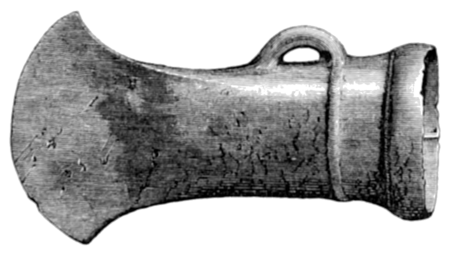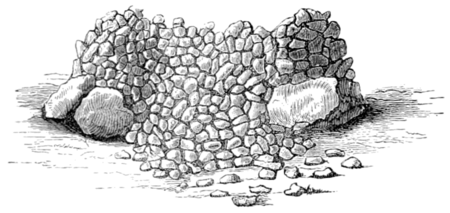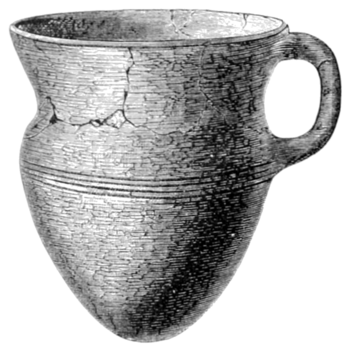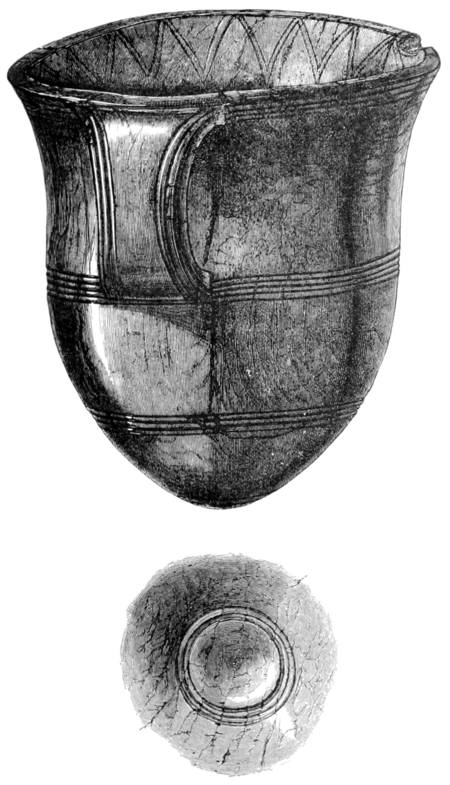Archaeological Journal/Volume 29/Notes on the Pre-historic Archæology of East Devon (Part 1)
NOTES ON THE PRE-HISTORIC ARCHÆOLOGY OF EAST DEVON.[1]
By the Rev. RICHARD KIRWAN, M.A., F.S.A., F.E.S.L., Rector of Gittisham.
In conformity with an inexorable law, the generality of mankind have ever passed away unnoticed and forgotten; yet each succeeding age has produced individuals distinguished above their fellows, whose names have been rescued from oblivion. Hence the origin of sepulchral memorials. From an instinctive desire on the part of the survivors to embalm the memory of those who in life were eminent for their wisdom or their valour, and sometimes also from feelings of affection, an effort was made to secure their remembrance by setting up over their remains some enduring sign or symbol. Thus Jacob set up a monument or pillar over the grave of Rachel, and Absalom built himself a pillar to hand down his name to posterity.
Amongst the ancient Britons, the earliest sepulchral memorials, like those of other ancient nations in a similar state of barbarism, were simply mounds of earth or of unhewn stones; and these, if we except the cromlechs here and there remaining, were the only funeral monuments of this island previous to its becoming a province of the Roman Empire. These tumuli or barrows lie scattered over all parts of the kingdom, though they occur more particularly in the most barren and exposed districts. On the hilly and uncultivated downs of Dorsetshire and Wiltshire they abound, as also in some parts of Scotland and Wales, whilst in other parts they are comparatively unknown. Some have been destroyed at different times as agriculture has progressed, whilst those that still remain are commonly placed on elevated situations that have not yet been invaded by the advancing plough. When regarded as affording a clue to the manners and customs of the early inhabitants of this island, these sepulchral mounds are most important and interesting, inasmuch as from an examination of their contents some idea may be gained of the knowledge and progress in the industrial arts, and of the comparative state of civilisation attained by a people whose very name has passed into oblivion. In fact, as the geologist, by reference to the fossil fauna and flora of the successively overlying strata, is enabled to recall the various forms of life that once peopled our globe, so does the archæologist exhume from the barrow materials for the elucidation of the history of races that have long since passed away. Of all the branches of scientific inquiry, this is, perhaps, the most interesting, enabling us to extend our knowledge of the civilization, the social and domestic habits, the religious rites, the attainments in science and art of the ancient tribes of our land.
From an investigation of their sepulchral mounds, it is evident that the Britons were accustomed to employ two distinct modes of burial; the one by simple inhumation, which was the more ancient, where the body was deposited entire, and generally in a contracted position, with the knees drawn up to the chin; the other by cremation, where the body was burnt. Homer mentions this custom as having prevailed at the siege of Troy; we find also some reference to it in the Old Testament; it was a custom that appears to have originated among some Eastern nations, and was possibly introduced into this country by the Phœnicians. Viewed with reference to their external conformation, British barrows present considerable variations; and, taking outward form as a basis of classification, numerous and fanciful designations have been given to them by Stukeley and others. The classification which is now generally adopted, and which was proposed by Dr. Thurnam, recognises two primary forms, namely, the long barrow and the round barrow; of the latter three modifications are admitted, which are,—bowl-shaped barrows, bell-shaped barrows, and disc-shaped barrows. The most ancient are the long barrows. They occur, though rarely, in Yorkshire, Wiltshire, and Gloucestershire; none are known to exist in Devon[2] or Cornwall. They are never found together in groups, but singly, and on elevated ground. The primary interment in these was by simple inhumation, and, as no object of metal has been found in them, they are referred to the Stone Age. Of the round barrow, examples of each of the three modifications of form that I have mentioned are found in the neighbourhood of Honiton. With one exception, all the barrows on Broad Down and Gittisham Hill are bowl-shaped; the exception occurs in the southern- most member of the group at Broad Down, which is a good example of the form known as the disc-shaped barrow; it is about 120 ft. in diameter, 4 ft. in perpendicular height, flat on the top, and presents the appearance of an inverted shallow dish. At Buckerell Knapp, about three miles west of Honiton, are some striking examples of the bell-shaped barrow.
Of the group of barrows at Broad Down several have now undergone a careful investigation. The result of the excavation of three of them I have already described in detail.[3] Upon the occasion of the meeting of the British Association in Exeter in 1869, an excursion was arranged to Gittisham Hill, when, by permission of R. Marker, Esq., two barrows, situate at the northern extremity of the group, were opened in the presence of the visitors. The first was, to all appearance, a large and perfect tumulus; it measured about 60 ft. in diameter, and 5 ft. in perpendicular height at the apex of the mound. We were, however, disappointed on ascertaining by digging that it had been previously disturbed, and that the interment, whatever it may have been, had been removed. We found only the fragments common to all spoliated barrows, namely, a few crumbling bits of burnt bones, some flakes of flint, one or two shards of coarse pottery, some round pebbles that had been probably used as sling-stones, pieces of hæmatite,[4] fragments of charcoal, rough stones, such as are common on the surface of the uncultivated ground, and many of which had acquired a glazed appearance by the vitrifying of their surfaces, and otherwise bearing marks of the action of fire. A Queen Anne's shilling, probably cast in when the contents of the barrow were abstracted, was also discovered in the rubbish that was thrown out from the trench.
Some twenty yards to the east of this barrow lay another of smaller size, to which we next directed our attention. By our excavations it appeared that the spot to be occupied by the barrow had been marked out with large masses of chert, placed at equal distances apart, and arranged so as to form a circle about 50 ft. in diameter. From the appearance of the earth upon which the base of the barrow rested, it was judged that the process of cremation had taken place on the spot, the body having been reduced to ashes on the natural surface of the ground, and that the mound, consisting of surface-earth sparingly mixed with stones, was raised over the site of the funeral pyre as it remained when burnt out. The convexity of the heap was mainly preserved by a covering of stones, placed, with some regard to regularity, on the surface. We removed a considerable portion of the area of this barrow from the centre towards the south-east, and also displaced the larger masses of stone that we met with, and which have been spoken of as arranged so as to form a peristalith just within the circumference of the barrow. Beneath one of them occurred four shapeless fragments of bronze, which appeared to have originally formed portions of a cake of metal that had been smelted in the saucer-shaped cavity of a stone, and which were obviously intended for casting purposes. They weigh respectively, 10 oz., 812 oz., 512 oz., and 112 oz.
Attention has been called to the fact, as somewhat remarkable, that whilst the south-western counties of England present abundant evidence of extensive early occupation, in the numerous entrenchments that crown the hills in all parts, and in the traces also of ancient industry and primitive habitations that occur on Dartmoor and in many parts of Cornwall, so few examples should have been found of those objects of bronze most frequently obtained in almost every part of the British Islands—the celt and the palstave. This rarity of "finds" of bronze implements would appear the more unaccountable when it is remembered that tin and copper, which are the constituents of bronze, are found lying frequently side by side in Devon and Cornwall, and perhaps in no other known part of the globe. And yet, judging from our own experience gained at Broad Down, it would appear as if these relics were not so scarce as had been supposed. It will be remembered that at Lovehayne, about a mile distant from Broad Down, a deposit of about a hundred of these implements was brought to light when a stone barrow was destroyed by some road-makers in 1770.[5] In the Albert Memorial Museum in Exeter is another example of the palstave, that was picked up by Mr. Fowler, of Honiton, in the immediate vicinity of Farway Castle. Other examples have also occurred in Devon, at Morebarton, in a field near Sub Hill, between Clyst St. Lawrence and Rockbeare,[6] and at Rumby, near Bovey Tracey; whilst several bronze taper blades were discovered in a field near Escot, some of which have been presented to the Museum at Exeter by Sir John Kennaway, Bart., the remainder having been deposited in the National Collection at the British Museum. These remarkable weapons have been figured and described by Mr. Charles Tucker, in this Journal.[7] A more recent and remarkable discovery of bronze implements in Devonshire occurred at Plymstock, on the estate of the Duke of Bedford, in 1868; they have been presented by his Grace to the British Museum, a few specimens only being reserved for the Exeter Collection. These and the other "finds" that I have alluded to are described by Mr. Albert Way, in this Journal.[8] The fact of the discovery of those four pieces of bronze in the barrow at Gittisham Hill is of importance also, as helping to solve the question whether the weapons of bronze which have been occasionally found were fabricated in Britain, or were imported from other countries. The answer to this inquiry is not without importance to our early history. For if we may assume, as I think we are entitled to do, that the bronze celt, the palstave, the spear-head, and the blade-weapon—examples of each of which have occurred in East Devon—are actually native productions, we have here a decided proof that our forefathers in the Bronze Age enjoyed a certain degree of civilization. A savage people, destitute alike of the knowledge and of the love of the arts of peace, could not have possessed cither energy or ability to manufacture implements which often display both taste and skill. The native character of these objects was, moreover, rendered probable by the discovery at Bovey Tracey of moulds of stone, in which it was intended that they should be cast;[9] the occurrence of these pieces of unwrought metal to which I have referred, affords an additional link in the evidence which tends to prove that the casting was executed on the spot.
We proceeded to a third barrow, situate at a distance of about half a mile to the south of the two that I have described, and commanding an extensive view both by land and sea. We found that it consisted of two distinct barrows of different structure; or, to speak more accurately, a later barrow of earth had been raised upon the surface of the original mound, which proved to be a large cairn, formed entirely of loose stones aggregated into a heap. Excavating as near the centre of the upper or earthy barrow as possible, we found that the mound was composed of soil firmly compacted, and interspersed here and there with fragments of charcoal. We failed, however, in our hasty excavation, to discover an interment; and time precluded our disturbing the cairn beneath.
During the year 1869, the members of the Exeter Naturalists' Club visited Broad Down, by invitation of Sir Edmund S. Prideaux, Bart., when three barrows were opened in their presence. The first occupied the eastern extremity of the down. It was composed of peat intermingled with large rough stones and flints; and, with an elevation of three feet, it covered an area of about twenty-five feet in diameter. We directed a trench to be cut from the south side towards the centre; we then enlarged our excavations by removing all the large stones, which appeared to be arranged in a circle, but the labour was devoid of any practical result. We then inspected a series of seven barrows arranged in a line running north and south, and separated one from the other by an interval of about twenty yards. Our excavations were commenced on the eastern side of the fourth member of the group (reckoning from the south), and had not extended more than a few feet when an abundant deposit of charcoal testified to the presence of the funeral pyre; partially buried in this deposit there lay a well patinated celt of the socketed type, in perfect preservation. It lay upon its side, with the cutting edge inclining upwards, and turned towards the centre of the mound. (Fig. 1.) Its extreme length is 314 in. the width of the cutting edge is 134 in., and the diameter of the socket, which is nearly circular, is about 114 in.; it has a small car or loop upon one side, and both externally and internally preserves the ridge or seam left at the joint of the mould at the time that it was cast. With the exception of a narrow band of slight elevation which encircles the weapon in a plane coincident with the anterior end of the loop, it is destitute of any attempt at ornamentation. The sides appear to have been hammered, and the cutting edge presents evident signs of wear, especially towards the extremity of the side opposite to that on which the loop is placed. The same is also the case with another celt of similar type obtained at Honiton, and supposed to have been originally brought from Lovehayne, near Broad Down.[10]
Fig. 1.—Bronze socketed celt, found in a kist-vaen, in a barrow on Broad Down, near Honiton. Length, 314 in.
Albert Memorial Museum, Exeter.
Fig. 2.—Ground plan. a, kist-vaen; b, mound of earth; c, trench; d, peristalith. Barrow on Broad Down, near Honiton, excavated in 1869.
Barrows on Broad Down, near Honiton.
Proceeding with the removal of the remaining soil, as we approached the centre of the barrow, we struck upon what proved to be the nucleus of the surrounding mound, in the shape of a rude vault or chamber, formed with unhewn stones such as are common in the locality and which, by exposure to the atmosphere whilst lying upon the surface of the ground, have their angular points rounded off. Upon clearing away some of the surrounding earth, we found that this kist-vaen formed a domed-shaped structure, the stones of which were ingeniously piled together upon the principle of the horizontal arch, whilst externally it was surrounded by a circle of larger stones, upon which it partially rested, and which appeared to be intended to act as buttresses. (See the ground-plan, fig. 2, and the woodcuts, figs. 3, 4.) After carefully observing the mode of structure employed in the erection of this simple tomb, we removed the covering stone at the apex of the dome, and upon looking within were rewarded by finding the interment. The base of the chamber, which was paved with three flat stones rudely fitted together, was almost entirely covered over with calcined human bones, presenting a confused mass of the relics of humanity. In this case the bones were not only without ashes, but seemed so free from extraneous matter, that they must have been most carefully selected from the funeral pyre.
Fig. 5.—Bone bead, found in a kist-vaen, in a barrow on Broad Down,
(Original size.)
Associated with the remains were the bones of an infant, the fragments of the skull being especially observable, and also a bone bead (fig. 5), which had probably been used to fasten the cloth or shroud within which the remains were inclosed after their removal from the pyre.
We now proceeded with the investigation of a third barrow, formed of peat and clay, with occasional indications of charcoal. It was situate close to the road-side, not many yards distant from the barrow examined in the presence of the Devonshire Association in 1868. In diameter it was about 36 ft., and in height about 3 ft. In the centre of the mound was a simple deposit of burnt bones and ashes, unaccompanied by pottery or implements of any kind.
Upon a subsequent occasion I was enabled to proceed with the investigation of the group of seven barrows, which occupy the eastern escarpment of Broad Down. The tumulus which now came under our notice occupied the centre of the group, and was situated about twenty yards to the south of that described above as enclosing a kist-vaen. It was about 7 ft. in perpendicular height, 120 ft. in diameter, and surrounded by a shallow fosse, beyond which again were the remains of a peristalith, consisting of masses of chert, arranged in a circle, at equal distances apart. Upon removing the outer surface of the mound to a depth of about 3 ft., we came in contact with a central mass or cairn of flints. A considerable amount of time and labour were expended in the removal of this construction, which was built up of small stones, and was wanting in the constructive skill and ability displayed in the adjoining barrow that we had previously investigated. The domed roof had fallen in, the sides had bulged out, and the kist-vaen, through lapse of time and the pressure of the earth upon it, had degenerated into a confused heap of stones. (Fig. 6.) This heavy portion of our labour having been at last surmounted, we came on a deposit of burnt hones, packed within the layers of the bark of a tree, and resting upon this were the remains of a bronze spear-head (fig. 7), much corroded. Subsequently we found the rivet by which this implement was affixed to the haft. Proceeding carefully with the displacement of the stones, we were gratified to observe a drinking-cup (fig. 8) at the further or eastern extremity of the cairn. It lay upon its side at a distance of about 3 ft. from the burnt remains; and though it was firmly wedged within a compact mass of stones, we were enabled to remove it almost entire from its long hiding-place. It measured 314 in. in }}Relics found in 1869 in a cairn, within a barrow on Broad Down, near Honiton.
(Two-thirds original size.)
Now preserved in the Albert Memorial Museum at Exeter.
Fig. 9.—Drinking cup of bituminous shale, found in 1868 in a barrow on Broad Down, near Honiton. Original size. Now preserved in the Albert Memorial Museum at Exeter.
Subsequently a third barrow of this group of seven has been investigated. It lay about twenty yards to the south of the central tumulus, and, attaining a perpendicular height of about 6 ft., was about 90 ft. in diameter. We found, as before, a mass of peat and clay piled upon a central cairn of flints. within this, at the base of the barrow, was the interment of burnt bones, completely enshrouded within an accumulation of the roots of the furze; and near to the bones were the fragments of a bronze implement, too much decayed to enable us to recognise the type. Outside the cairn, on its southern side, was an accumulation of charcoal, marking, doubtless, the spot where the process of cremation occurred.
The opening of these barrows affords, it is presumed, a complete insight into the mode of burial which prevailed at the time that the barrow-builders lived in East Devon. In each instance we have found that the mound has been raised over calcined human bones, which, in many cases, lay in the same place on the natural surface of the ground that they occupied when the embers of the funeral pyre were smothered by the casting up of the earth of the tumulus. The bones and black ashes of the pyre, reduced by compression to a layer of about a couple of inches in thickness, generally cover a space of about four or five feet in diameter in the centre of the mound. In two instances, we have found that a large portion of the earth forming the mound has been subjected to the action of fire, whilst in the majority of cases the mound consisted of black or greyish-coloured earth, formed by the decay of the turf and humus pared off from the site of the barrow, and from the space occupied by the fosse that surrounded it. We can only approximate to a date for these barrows. Subsequent observations have, however, tended to confirm the conjecture at first hazarded, namely, that they are to be referred to a period anterior to Cæsar's landing, when bronze, though known, was scarce.[12] It is safer not to attempt to fix any specific date, but to say, as we may with confidence, that they belong to a period which ends a century or two before the occupation of Britain by the Romans.
The Institute is indebted to the kindness of the Author for the Illustrations of the foregoing Memoir.
- ↑ Reprinted, by the author's kind permission, from the Transactions of the Devonshire Association for the Advancement of Science, Literature, and Art. 1870.
- ↑ The hill near Honiton, known as "Round Ball," may be a long barrow: it is certainly artificial.
- ↑ Transactions of the Devonshire Association, vol. ii. p. 619, plate ii.
- ↑ The occurrence of ruddle or hæmatite in barrows in Devon has been noticed in this Journal, vol. xxv. p.295, where the possibility that it may have served as body paint is suggested.
- ↑ Archaeological Journal, vol. xxvi. p. 341, and Transactions of the Devonshire Association, vol. ii. p. 647, plate ix.
- ↑ The implement here referred to is now used by a quack doctor as a charm for wens, and other affections of the throat.
- ↑ Notices of Antiquities of Bronze found in Devonshire, Archaeological Journal, vol. xxiv., p. 110.
- ↑ Antiquities of Bronze found in Devonshire, Archaeological Journal, vol. xxiv. p. 339; Supplementary Notices to the Memoir of Mr. Charles Tucker, in vol. xxvi.
- ↑ Arch. Journ. vol. xxiv. p. 112.
- ↑ Figured in this Journal, vol. xxvi. p. 313.
- ↑ Archaeological Journal, vol. xxv. p. 296. and Transactions of the Devonshire Association, vol. ii. p. 626.
- ↑ Compare the remarks given in the Journal, vol. xxv. p. 311.








